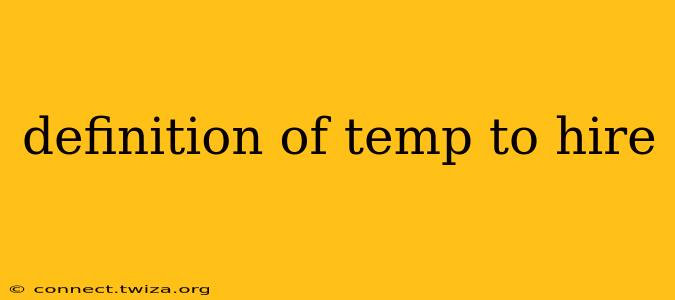Temp-to-hire, also known as temporary-to-permanent employment, is a staffing strategy where a company hires a temporary employee with the potential to transition into a full-time, permanent role after a trial period. This arrangement allows employers to assess a candidate's skills, work ethic, and cultural fit before making a long-term commitment. It also offers temporary employees a pathway to secure stable, permanent employment. This arrangement benefits both the employer and the employee, providing a risk-mitigation strategy for hiring managers and a valuable opportunity for job seekers. Let's delve deeper into the intricacies of this increasingly popular employment model.
What are the benefits of temp-to-hire for employers?
For employers, the temp-to-hire model offers several key advantages:
- Reduced Hiring Risk: Instead of immediately committing to a full-time employee, companies can evaluate candidates in a real-world work setting. This minimizes the risk of a costly mismatch in skills or personality.
- Flexibility and Scalability: Temp-to-hire arrangements provide flexibility to adjust staffing levels based on project needs or seasonal demands. It's particularly useful for handling short-term projects or covering employee absences.
- Cost-Effectiveness: Temporary employees often come at a lower cost than permanent employees, including reduced benefits and overhead expenses. This can significantly impact the bottom line, especially during periods of uncertainty.
- Improved Productivity: By selecting a candidate who demonstrates a strong work ethic and fits the company culture, temp-to-hire can lead to improved team productivity and overall efficiency.
- Access to a Wider Talent Pool: Utilizing a staffing agency allows access to a larger and more diverse pool of candidates than might be reached through traditional recruitment methods.
What are the benefits of temp-to-hire for employees?
Temp-to-hire positions offer several benefits to job seekers:
- Gaining Experience and Skills: Temporary assignments provide valuable work experience and the opportunity to develop new skills, making candidates more competitive in the job market.
- Networking Opportunities: Working temporarily within a company provides the chance to build professional networks and make connections that could lead to future opportunities.
- "Foot in the Door": It acts as a trial period, allowing the employee to showcase their abilities and prove their value to the company, increasing the chances of a permanent offer.
- Improved Marketability: The experience gained during a temporary assignment can strengthen a resume and make it more appealing to future employers.
- Immediate Income: While searching for permanent employment, a temporary position provides immediate income and financial stability.
How long is a typical temp-to-hire period?
The duration of a temp-to-hire arrangement varies significantly depending on the position, company, and individual performance. It can range from a few weeks to several months. The length of the temporary assignment is usually clearly defined in the contract, along with the criteria for conversion to a permanent position.
What are the typical steps in a temp-to-hire process?
The temp-to-hire process generally involves these steps:
- Application and Screening: The candidate applies through a staffing agency or directly to the company. The initial screening involves resume review and potential interviews.
- Temporary Assignment: The candidate is hired on a temporary basis, typically with a clearly defined end date.
- Performance Evaluation: Throughout the temporary period, the employer evaluates the employee's performance, skills, and cultural fit. Regular check-ins and feedback sessions are crucial.
- Conversion to Permanent Employment: Based on satisfactory performance, the employer offers a full-time, permanent position. This offer typically includes benefits and other compensation associated with permanent employment.
How is a temp-to-hire different from a contract position?
While both temp-to-hire and contract positions are temporary, they differ significantly in their objective. A temp-to-hire position is intended to transition into permanent employment, while a contract position has a pre-defined scope of work and a predetermined end date, with no expectation of permanent employment.
What are some common pitfalls to avoid in temp-to-hire arrangements?
Both employers and employees should be aware of potential pitfalls:
- Unclear Expectations: A lack of clarity regarding performance expectations, responsibilities, and the criteria for conversion can lead to misunderstandings and disappointment.
- Lack of Communication: Open and consistent communication between the employer, employee, and staffing agency is crucial for success.
- Ineffective Performance Evaluation: A fair and objective performance evaluation process is essential to ensure an equitable transition to permanent employment.
Temp-to-hire offers a strategic approach to hiring that benefits both employers and employees. By understanding the intricacies of this process and avoiding common pitfalls, both parties can maximize the advantages and achieve a mutually beneficial outcome.
